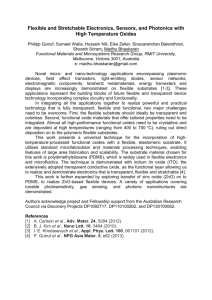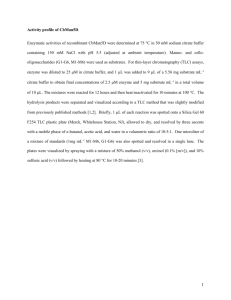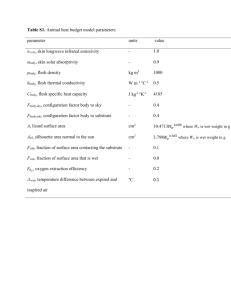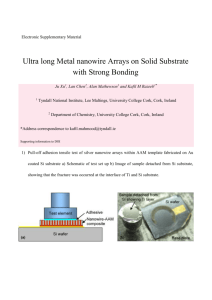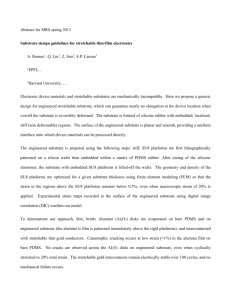The MFP supplementary material as a word file
advertisement
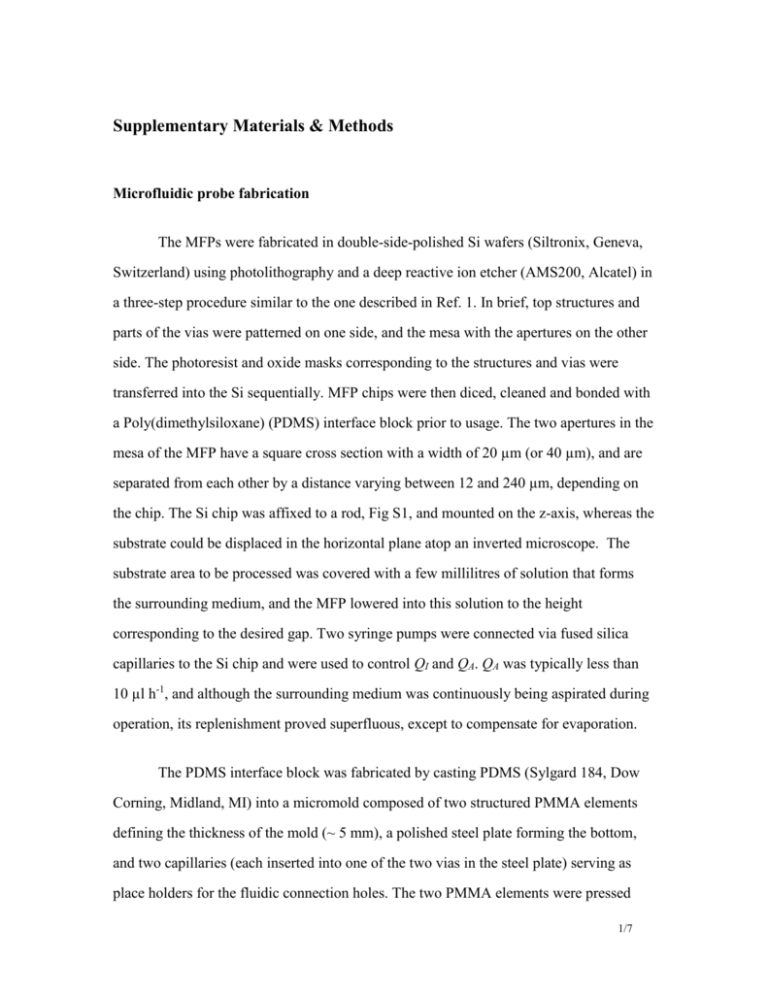
Supplementary Materials & Methods Microfluidic probe fabrication The MFPs were fabricated in double-side-polished Si wafers (Siltronix, Geneva, Switzerland) using photolithography and a deep reactive ion etcher (AMS200, Alcatel) in a three-step procedure similar to the one described in Ref. 1. In brief, top structures and parts of the vias were patterned on one side, and the mesa with the apertures on the other side. The photoresist and oxide masks corresponding to the structures and vias were transferred into the Si sequentially. MFP chips were then diced, cleaned and bonded with a Poly(dimethylsiloxane) (PDMS) interface block prior to usage. The two apertures in the mesa of the MFP have a square cross section with a width of 20 µm (or 40 µm), and are separated from each other by a distance varying between 12 and 240 µm, depending on the chip. The Si chip was affixed to a rod, Fig S1, and mounted on the z-axis, whereas the substrate could be displaced in the horizontal plane atop an inverted microscope. The substrate area to be processed was covered with a few millilitres of solution that forms the surrounding medium, and the MFP lowered into this solution to the height corresponding to the desired gap. Two syringe pumps were connected via fused silica capillaries to the Si chip and were used to control QI and QA. QA was typically less than 10 µl h-1, and although the surrounding medium was continuously being aspirated during operation, its replenishment proved superfluous, except to compensate for evaporation. The PDMS interface block was fabricated by casting PDMS (Sylgard 184, Dow Corning, Midland, MI) into a micromold composed of two structured PMMA elements defining the thickness of the mold (~ 5 mm), a polished steel plate forming the bottom, and two capillaries (each inserted into one of the two vias in the steel plate) serving as place holders for the fluidic connection holes. The two PMMA elements were pressed 1/7 onto the steel plate using screws. The PDMS was degassed under vacuum and poured into the mold. The setup was then placed on a hot plate at 48 °C for pre-curing the PDMS and then in an oven at 60 °C for at least 1 h. This two-step procedure helps minimize the generation undesired air bubbles. Thereafter, the PDMS block was removed from the mold and stored until it was bonded with the Si chip. The PDMS block and Si chip were activated in air plasma (Tepla 100-E) at 1 mbar for 24 s at 230 W, and joined together using a self-made mechanical alignment aid. The joined PDMS block and Si chip were then placed overnight in an oven at 70° C. Experimental setup Liquid flow was driven by syringe pumps (Genie, Kent Scientific) mounted with syringe having a capacity of 1 (# 7101, Hamilton) and 10 microlitres (# 1701,Hamilton) for injecting and aspirating, respectively. The syringes were connected to fused-silica-glass capillaries with 360 µm o.d., with i.d. of 50 and 100 µm i.d. (FS-150 and FS-110 respectively, Upchurch Scientific), and a length of ~ 15 and ~ 25 cm, resulting in a dead volume of ~ 0.3 and ~ 2 µl, respectively. Adapter sleeves, fingertight fittings and unions (silica SealTight™ sleeves and Nanotight™ fittings and unions, Upchurch Scientific) were used to connect the syringe pumps to the glass capillaries. At the other end, the capillaries were inserted into the PDMS interface block and until they contacted the Si chip. A working stage was mounted onto the inverted microscope and used to support the motorized axes (Limes 90, OWIS, Germany) for x and y positioning of the substrate, and for z positioning for the MFP. The axes were computer-controlled (L-step, OWIS, Germany), and the displacement paths programmed with the control software. The 2/7 substrate was clamped into a self-made carrier using two leaf springs. The horizontality of the substrate was adjusted using micrometer screws arranged in a three-point support configuration on the carrier. The mesa of the MFP was aligned with the substrate by means of an adjustable tilt stage (Melles Griot). The Newton’s rings formed between the mesa and the substrate could be observed with the inverted microscope and served to adjust the parallelism. Imaging setup & procedures The fluorescent flow fields and patterns were viewed using an inverted microscope (Eclipse TE300, Nikon). Images were recorded either with a cooled, low-noise CCD camera (Sensicam, PCO, Germany) or a consumer camera (Nikon Coolpix 990, Sony DCR-PC 330E, both for still images and videos) if color information was required and luminosity allowed it. Patterned substrates that required both a high resolution and a large field of view were imaged using a microarray scanner (BA4F, Lavision-Biotec, Germany). Here, TRITC and FITC channels were taken separately by switching the corresponding filters; and then the two images coloured and joined together digitally (Image Pro 5, Media Cybernetics Inc., USA). Experimental procedures Deionized water was produced with a Simplicity 185 system (Millipore). Chemicals were from Fluka and proteins from Sigma, unless otherwise indicated. In the experiments shown in Fig 2, Fluorescein isothiocyanate (FITC, green, FE = 520 nm) labelled goat immunoglobulin G (IgG) was dissolved in Phosphate buffer saline (PBS, BupH, Pierce) 3/7 at 1 mg ml-1 and an APTS glass slide was used as substrate. In Fig 3A, a HCX slide (Xantec GmbH, Germany) served as substrate. This slide featured an NHS-activated carboxylated hydrogel. Proteins from solution bind to this coating in a two-step process: First, electrostatic interactions help adsorb the proteins to the carboxylated groups of the hydrogel. This requires working at low salt concentration and at a pH below the pI of the proteins because then the proteins are positively charged and readily adsorb from the solution to the negatively charged carboxyl group at a very high rate. Second, the NHS group reacts with the proteins and covalently immobilizes them in the gel matrix within a few minutes. IgGs labelled with tetramethylrhodamine isothiocyanate (TRITC, red, FE = 570 nm) were prepared as a 3 mg ml-1 solution in 10 mM phosphate buffer, pH 6.0, and flushed in the microjet across the substrate. The same buffer also served as surrounding medium. Non-labelled anti-goat rabbit IgGs were patterned using the same concentration and buffers. After quenching the NHS groups, the slide was incubated for 30 min with 200 µg ml-1 FITC-labelled anti-rabbit goat IgGs in PBS buffer containing 1% bovine serum albumine (BSA). After thorough rinsing and drying according to the manufacturer’s specifications, the slide was imaged. For the gradient array of Fig. 3B, 1 mg ml-1 TRITC-goat IgGs were dissolved in 10 mM phosphate buffer, ph 6.0, which also served as surrounding medium. The dodecahedron of Fig. 3C was drawn with FITClabelled goat IgGs dissolved in 5 mM acetate buffer, pH 6.0, and with water as surrounding medium. The prominent edges of the polyhedron were drawn with a gap of 10 µm at a speed of 10 µm s-1 and with a ratio QA/QI of 3.5, whereas the hidden edges were drawn at a speed of 100 µm s-1 and with a ratio QA/QI of 5.75. Here, the injection pump was stopped and re-started for drawing the edges. 4/7 To generate the homogeneous fluorescent protein layer patterned in the experiment of Fig. 4A, a HC slide (same hydrogel coating as HCX slide but without NHS groups, from Xantec, Germany) was activated according to the manufacturer’s specifications and incubated for 15 min with 1 mg ml-1 TRITC labeled goat IgGs in 10 mM phosphate buffer, pH 6.0. The proteins were then selectively removed with a microjet of 0.1 M Carbonate buffer at pH 11.5 with 1M NaCl and 0.2% Triton-X, and with 50 µg ml-1 fluorescein for flow visualization. Fibroblast cells (3T3 line) were kept under standard culturing conditions in Dulbecco's modified Eagle's medium (DMEM) containing Glutamax I (GIBCO Life Technologies) and sodium pyruvate, supplemented with 10% heat-inactivated fetal bovine serum (Sigma Aldrich) and 1% antibiotic/antimycotic solution (GIBCO Life Technologies). The cells were plated on glass cover slips at least 24 h prior to the experiments at a seeding density of approximately 10,000 cells cm-2. For the experiment, a cover slip was placed on a glass slide in the working stage, and the same medium, but without serum supplement, was used to cover the adherent cells. The working stage had been enhanced with heating mats and temperature sensors, which were interconnected through a PID controller to adjust the temperature on the glass slide. To minimize evaporation, a transparent plastic film was used to cover the stage. A PBS microjet containing 1.25% trypsin, 0.02 % EDTA, as well as 1 µg ml-1 fluorescein for visualization was used to detach individual fibroblast cells adhering to the cover slip. 5/7 Calculations The Péclet number is a measure of the convective versus diffusive transport and helps evaluate whether diffusion can broaden the hydrodynamically-confined microjet. Pe 2 RH v Dn , where RH is the hydraulic radius, v the average flow speed and Dn the diffusion constant of the solute; the lower the flow speed, the larger the broadening. In our case, the lowest aspiration flow rate was QA = 1.1 nl s-1. The average flow speed in the concentric flow field generated between mesa and substrate by the aspiration flow from the outside towards the inside equals the flow rate divided by the cross section. The larger the gap, the larger the cross section and the slower the flow. Therefore the largest gap G = 50 µm results in the slowest flow and is used for calculating the Péclet number. The injection flow rate can be considered as a local perturbation and is neglected in this calculation. The cross section of the channel at the aspiration aperture is the perimeter of the aperture (4·20 µm) multiplied by the gap, that is, 4·103 µm2. The cross section linearly increases for increasing distances from the aspiration aperture and takes the value of the circular perimeter of radius r multiplied by the gap G, which at the far-edge of the injection aperture (for a separation S = 30 µm, r = 60 µm) is 1.88·104 µm2. For these two cross sections, the average flow speed is 275 and 59 µm s-1, respectively. The hydraulic radius is defined as RH = 2A/P where A is the cross section of the channel and P the perimeter. The perimeter takes the value of 2·2πr, corresponding to the perimeter of the circle on the substrate and on the mesa of the MFP. There are no lateral sidewalls, which is equivalent to a slit of length 2πr. Interestingly, we find that RH = G, and because v = f(G-1), Pe is independent of the gap G for HFC. For IgGs with a typical diffusion constant Dn = 4·10- 6/7 11 m2 s-1, the Péclet number is Pe = 690 at the aspiration aperture and Pe = 147 at r = 60 µm. Convective transport is more than two orders of magnitude larger than diffusive transport, which therefore does not contribute markedly to the microjet enlargement. The Reynolds number Re is a measure of the ratio between inertial forces and viscous forces. Re 2 RH v , where is the density of the liquid and the viscosity. The value Re = 2000 is the empirical limit between laminar flow (Re < 2000) and turbulent flow (Re > 2000). For the experimental conditions described in the above paragraph, Re = 0.017 and Re = 0.08 at the aspiration aperture and at r = 60 µm, respectively, and corroborate the experimental observations of laminar flow conditions. 1. Juncker, D. et al. Soft and rigid two-level microfluidic networks for patterning surfaces. J. Micromech. Microeng. 11, 532-541 (2001). 7/7
